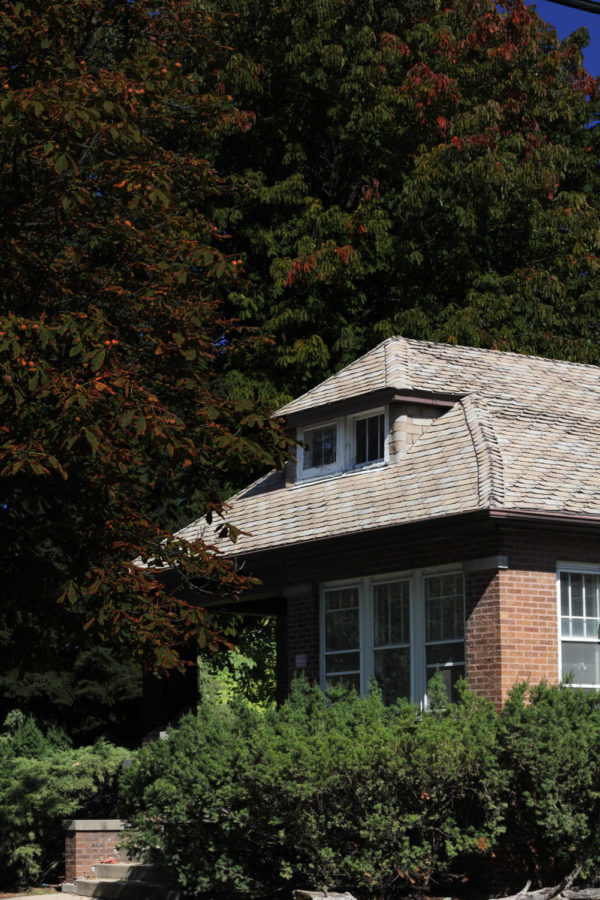Bringing Evanston’s mental health living room to life
Inside the city’s work to provide an alternative for Evanstonians facing mental health crises
The location for the Evanston mental health living room is just a block away from St. Francis Hospital.
Just south of St Francis Hospital stands a small brick house with a cement pathway leading to a brown wood front door. If you peek through the front window, you can see a completely bare room with a dusty wood floor and a fireplace on the back wall. Soon enough, this deserted brick house will be an oasis, a place for people in mental health crises to see professionals without needing health insurance or even a checkbook. It will be a place for anyone to feel safe, welcomed and helped.
Since the pandemic hit, the world’s mental health has deteriorated. With the shift to a virtual world in 2020 and ‘21, people became isolated and more prone to stress, anxiety, fear, sadness and loneliness. And mental health disorders, including anxiety and depression, worsened for many. This led to hospitals flooded with patients and social workers overwhelmed with clients who needed support.
On March 28, the Evanston City Council voted to address the mental health crisis head on. The council allocated $900,000 to create a mental health ‘Living Room.’
“Ideally, this [Living Room Program] would make an impact, because it would give people experiencing any sort of men- tal health crisis an immediate place to get support with professionals as opposed to checking into a hospital,” says Evanston First Ward Alderwoman Clare Kelly.
Kelly believes that the Living Room is a direct solution to some of the over- crowding in hospitals. And overcrowding isn’t the only reason that people in a men- tal health crisis shouldn’t be checking into hospitals; Hospitals can also be incredibly stress-inducing.
Kristen Kennard, the Director of Social Work Services at the Moran Center, explains, “When somebody is having a mental health crisis, it is very difficult to manage what is going on around you… And if you go to an emergency room, it is not the most trauma-informed, safe-feeling space. It is scary, and it is chaotic.”
Moreover, the innovation of the Living Room isn’t just about how it helps; it’s about who it helps. The program appeals specifically to the needs of homeless and low-income people.
People across the country who can’t afford mental health services often have to deal with their problems alone, and that can have dangerous psychological consequences.
According to the National Survey of Drug Use and Health in 2016, over 25 percent of the U.S population with a serious mental illness lives be- low the poverty line. However, less than 13 percent of the U.S. population at the time lived below the poverty line. The correlation between extreme poverty and mental illness is evident. That’s why the Living Room specifically benefits impoverished people.
As Kennard explains, “[The Living Room] will benefit those who don’t have ready access to support and resources… It is there for an individual, an individual who is in crisis and who needs support.”
The creation of the Living Room also brings another issue to light: Armed police officers are often the first ones to the scene of a mental health crisis. Kennard notes that when someone is having a hard time with substance use or homelessness, “it can be very alarming for their first point of contact to be a police officer.”
Police officers aren’t necessarily at fault for this fear since most of them have little to no training in dealing with serious mental health crises. But a lack of training makes it difficult for them to decide what to do in these kinds of situations, which may only lead to more problems.
That’s why, in a separate initiative, Evanston partnered with Trilogy’s First-response Alternative Crisis Team (FACT), which is a program that sends pairs of
mental health professionals to a mental health emergency instead of police officers. The goal is to reduce stress and provide safe access to professionals
for anyone who needs it.
Right now, police officers still respond to a lot of mental health calls, but Kennard hopes to see a bigger shift in the future. “Down the road, I hope that when calls come in to (police) dispatch, if they’re able to identify it as a mental health emergency, [FACT] will be dispatched by themselves, unless there is some imminent danger that’s reported or medical issue.” Kennard says. While the Living Room and FACT are two completely different pro- grams, they both represent a commitment by the city to improve mental health access in the community. But will these efforts actually work?
In Skokie, a successful Living Room program has already been implemented. The Living Room, open from 12 p.m. to 8 p.m. on every day of the week, has al- ready proved itself to be a crucial oasis in the Skokie community.
“[The Skokie Living Room] has had success being a space where somebody doesn’t have to commit themselves to a hospital to get support when experiencing anxiety, stress, or anything along those lines. Instead, they can go into a center staffed with a couple of counselors without a lot of questioning and bureaucratic tape.” Kelly says.
Essentially, the Skokie Living Room has been everything that Evanston hopes theirs will be. That’s also why the City of Evanston has Turning Point, the facilitator of the Skokie program, taking charge when Evanston’s location opens up.
All of these ideas and plans for address- ing the mental health crisis in Evanston are exciting for experts like Kennard, but they still need to be implemented. And right now, the location for the Living Room re- mains completely deserted. There’s not so much as a chair on the property, much less a functioning crisis center.
Kelly clarifies that the architect hired to design the Living Room has taken longer than expected to get plans back to the city, preventing the project from getting started. She hopes that the crisis center “will be up and running before the end of next year.”
However long the development process takes, the Evanston community will await the arrival of a new kind of assistance. As- sistance that is accessible and stress-free. Assistance that experts in the city hope will turn a page for all of Evanston; away from a time of crisis and towards a new era of mental health support.
Your donation will support the student journalists of the Evanstonian. We are planning a big trip to the Journalism Educators Association conference in Nashville in November 2025, and any support will go towards making that trip a reality. Contributions will appear as a charge from SNOSite. Donations are NOT tax-deductible.











